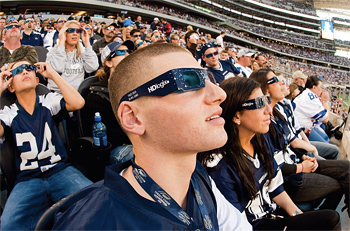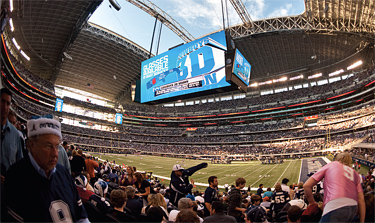HDlogix Demos Live 3D at Cowboys Game
DALLAS
The Dallas Cowboys are not an organization given to understatement. The team's majestic new, 90,000-seat stadium—which features two 160-foot by 72-foot Mitsubishi Diamond Vision HD video screens hanging from its roof—is testament to the franchise's penchant for making it big.
Last month, during a clash with the San Diego Chargers, the Cowboys used what has been billed as the world's largest HD display to demonstrate the first real-time 3D transmission at a sporting event that has the sports video world abuzz.

Every fan at the Cowboys-Chargers game last month was given a pair of 3D glasses to view the demo. ©Tom Hussey Photography, LLC While the 22-minute experiment, which took place from the end of halftime though the first part of the third quarter, wrapped with a loud Bronx cheer by many of the fans (who had been given free 3D glasses, but refused to wear them), the presentation also represented technical innovation with a retro flair that was reminiscent of moviegoers in the 1950s wearing 3D specs to the local cinema.
READY FOR MARKET
It was in September that Jim Spinella, CEO of Edison, N.J.-based HDlogix, felt that the company's technology was ready for industry feedback. "We got a positive response and went about bringing this technology to the attention of the market," said Simon Tidnam, vice president of sales & marketing.
By mid-November Spinella, a Cowboys season ticket holder, approached team owner Jerry Jones to show him HDlogix' technology.
HDlogix "is focused on HD," Tidnam said, "because our algorithms run better on a higher quality HD image." He noted that the box fits into the normal video workflow beside the encoder and that "it's a plug-'n-play solution, so no reinvention is required."
During the event, the Cowboys used their (usual) eight Sony HDC-1450 cameras and ran the signal through the Sony MVS-8000 switcher; then provided HDlogix with the existing 2D feed, which is treated as the left-eye view. "Then we generated the right-eye view and returned both signals to the screen to achieve the 3D effect," said Tidnam. "That's what the viewing audience saw."
Going "further up the food chain, so to speak, allows us to generate more depth into each frame," he said. "We try to turn your TV into a window that leads you to another experience but, in this case, that meant going from watching on TV to watching at the stadium."
INNER WORKINGS
While there is nothing new about 3D per se, creating and presenting it in today's production world requires "an immense amount of image and video analysis," said HDlogix CTO Will Gaddy. "You need to know how far away objects are from the camera, for instance, to create a depth map."
The preparation takes place before the crowd grabs their 3D glasses when HDlogix analyzes motion analysis, vanishing point and blur analysis.
For motion analysis, HDlogix employs optical flow. "That allows us to find which pixels are being hidden and which are being revealed when objects move," said Gaddy. "An occlusion gives key information about the relative distance of objects."
The vanishing point involves the convergence of lines to a given point, as a viewer would see when looking down a long hallway; that analysis enables HDlogix to glean more information about the geometry and depth of a scene; blur analysis concerns determining the depth of each scene (or the objects within it) from the blur of each pixel.
"Alone, these properties are not normally enough to get an accurate depth representation," said Gaddy, "but in combination and with the right constraint, you can acquire the necessary information for a good 3D experience."
He also noted a side effect of 3D viewing that HDlogix is careful to address. "We spend lots of time with viewers who stare at our images for hours on end to ensure that they don't get headaches or become nauseous," Gaddy said.
The reason? "Viewers in a theatre are normally watching a movie for 90 minutes, not the three hours-plus that a football game requires," he said, "so we make every effort to avoid eye fatigue."
3D EVERYWHERE?
That point was key, as the setup involved the traditional anaglyph method of display, which involves using the red/blue offset that make "the images appear out of registration," said Dwin Powell, director of broadcast engineering services for the Cowboys.
"Mind you, we weren't using Disney-like effects; rather, we were presenting real life," Powell said, adding that he and his crew monitored angles and movement for about two weeks before the game and made adjustments for the best depth.
"That became routine by game time," he said. "We liked the lower angles better than the higher angles, because there is more depth of field available when you shoot straight across. We also found that the effect was better if the shot was static and the action moved through the frame, because there was a fixed point of reference with focal points from the fronts and backs of the images."
Despite the crowd's reaction, he declared the experiment a success. "To me, it's a peek at the future," said Powell, who predicted that viewers "will get used to seeing 3D everywhere, even during the most mundane interviews."

The 22-minute demo drew cheers from some, jeers from others, who preferred to follow the action on the field. ©Tom Hussey Photography, LLC And HDlogix is hopeful that offering this glimpse into a new world of 3D will spur not only the sports industry, but the media world, to understand its potential. "The big challenge is to get consumers to buy HD sets with 3D capabilities," said Tidnam. "You can see them in Best Buy with 3D content loops, but once they get the set home, what kind of content will be available to the consumer?"
Today, he said, that consists of "a handful of the old 3D films and about 30 3D releases from Hollywood from 2009," with about 60 more slated for release in 2010.
However, HDlogix feels that sports will be a key driver of this trend "and that we are ideally positioned. This type of event is something that people had not contemplated because the technology wasn't there; now, it is."
STEPPING UP
In hindsight, Tidman feels that HDlogix might have further refined its marketing approach technically, but also deemed the effort a success.
"We branded the glasses to the Cowboys, not both teams, and there were a lot of Charger fans there," he said, also noting that the 3D transmission started at what turned out to be a critical juncture of the game. "And we should have further educated the fans with longer public address leads.
"But I know from our exit interviews that people liked it," Tidnam said, "and [color announcer] Phil Simms had kind words for the effort during the CBS broadcast. From our technical perspective, it went well."
Powell feels that eventually, fans will be able to watch 3D content at a game—without glasses. "But someone has to pioneer this art," he said. "Pioneers take the arrows and the settlers get the land, but someone has to take the arrows en route."
The professional video industry's #1 source for news, trends and product and tech information. Sign up below.
